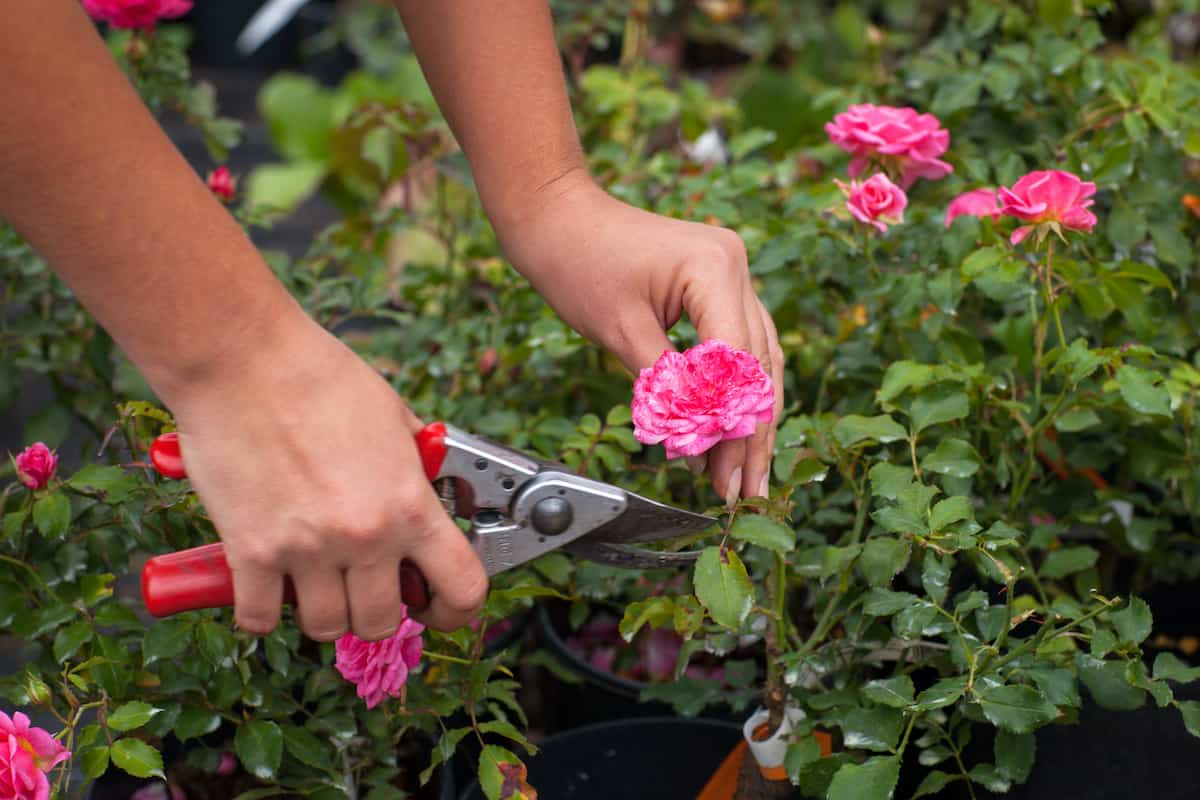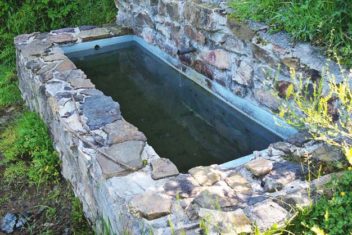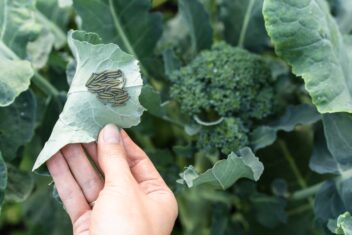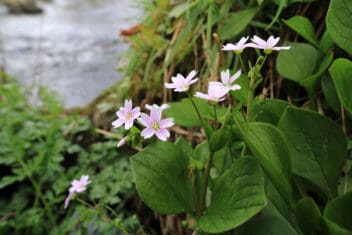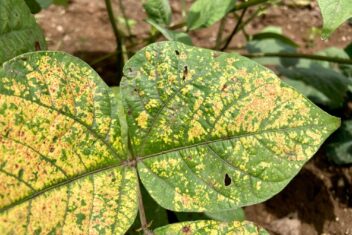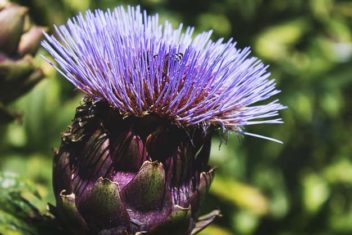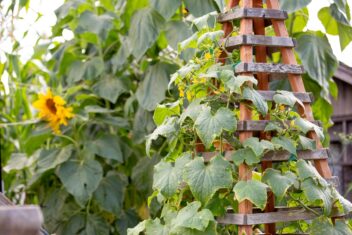Although it seems intimidating for a new gardener, learning the basics about how to prune roses isn’t hard and gives everyone the chance to have beautiful rose bushes in their garden.
When you search “pruning roses,” you might find a lot of rules that seem awfully complicated. But really, if you’re growing roses in the home garden, you don’t need to obsess over the process.
All you need is to understand the basic fundamentals, and you’ll be good to go. Here’s what you need to know!
Pruning Roses is Essential!
If you’re committed to having a rose bush, whether for ornamental reasons or culinary ones, then you need to understand that pruning is not an afterthought. It’s an essential step to have a healthy bush that produces gorgeous blooms.
Pruning might seem like a scary task, but it’s not challenging for the casual home gardener.
Here are the four main reasons why you need to prune your rose bushes.
- You need to remove dead and diseased branches, which are also called canes.
- It helps to rejuvenate your plant each year and encourage more blooms.
- Pruning encourages airflow throughout the bush which decreases diseases and fungal infections.
- It controls the size and shape of the bush.
Supplies That You Need to Prune Roses
Before you get started pruning roses, gather the right supplies. The list is simple.
- Good, Thick Gardening Gloves: If you can, buy a long glove that goes up your forearm to protect your sensitive skin in that area from the thorns
- Bypass Shears: Don’t buy anvils! Bypass blades overlap, creating a clean cut that is needed for rose bushes. Anvil blades meet and can crush the canes of your bushes.
- Long-Sleeved Shirt: For obvious reasons, it’s smart to cover your arms when dealing with rose bushes. Don’t wear your favorite silk dress shirt!
- Rose Bush Fertilizer: Make sure you have a fertilizer on hand to feed your bushes. Give the first feeding in the spring after pruning.
When to Prune Roses
The next big thing that you need to understand is when should you plan to prune your rose bushes. The answer varies based on where you live. Let’s look at the recommended guidelines.
Spring Pruning
Typically, the time that you want to do most of your pruning is in the early spring. For colder climates, wait until after the last frost date. Typically, whenever the plants start to bud or leaf out, it’s time for some pruning.
There are some general estimates based on USDA hardiness zones, but you also need to watch your weather for that year and your bush’s behavior.
- USDA Zone 3-4: The entire month of May
- USDA Zone 5-7: March 30 to April 30
- USDA Zone 8: Feb 22 to March 30
- USDA Zone 9: Jan 30 to Feb 28
- Zone 10: Jan 30 or earlier
Mark your calendars!
Summer Pruning
You don’t do any significant pruning in the summer, which is when the plant will create the beautiful blooms you dreamed of having. That said, it is smart to cut back dead flowers at any time throughout the summer.
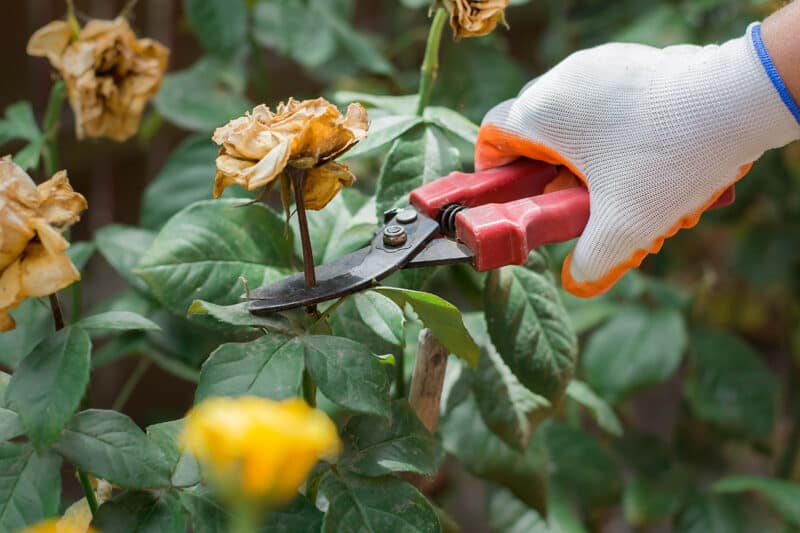
Deadheading encourages your bush to create more blooms. Some roses are self-cleaning, which means they deadhead themselves. If you don’t have one of these, you’ll need to keep on top of it yourself.
You can also prune away any diseased canes in the summer.
Fall Pruning
Once you have the first hard frost in your region, trim the longer stems to prevent from breaking throughout the winter. Trim back the top to stop the bush from being too top-heavy, which could spell trouble during strong winds.
If you find any crossing branches that could rub together, trim them back as well. However, don’t go crazy and trim too much, because excessive pruning stimulates growth. If that happens and your bush creates new growth before the winter, it could be damaged.
Also, dead or diseased parts of your bush should also be removed.
How to Prune Roses
Now that you have the supplies and know when to prune, it’s time to get to work!
Keep in mind that modern shrub roses and old roses have slightly different requirements. Old roses (teas, grandifloras, floribundas, etc.) bloom on new or one-year-old stems, so you want to prune them hard in the early spring.
Modern roses bloom best on older stems, so long as they aren’t woody. You want to leave a few older canes, and you can skip pruning the first several years.
1. Remove All Leaves
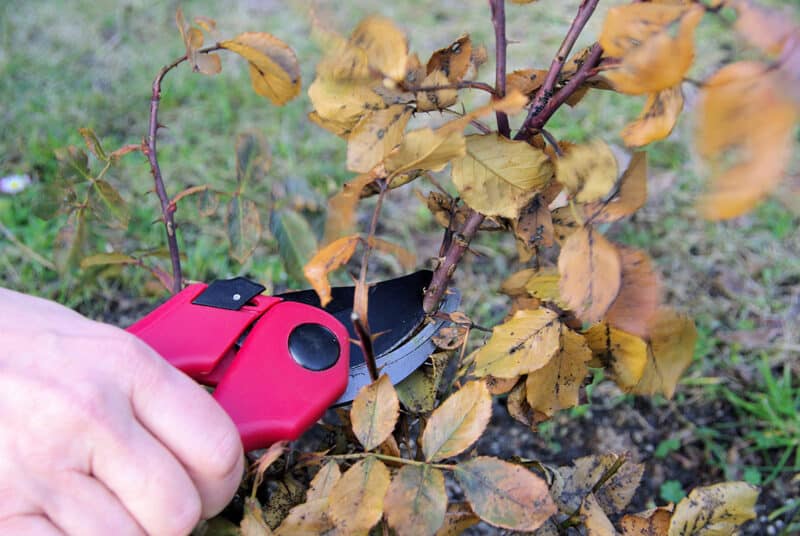
Before you start to prune the canes in the fall or early spring, you need to make sure that you can see the entire structure of the rose bush. All of the stems should be visible. If they aren’t, you need to make sure you remove any dead or brown leaves.
Doing this also has a second benefit. It removes any pests or diseases that could hang out on the foliage throughout the winter. That really does happen!
2. Cut Off Dead Wood
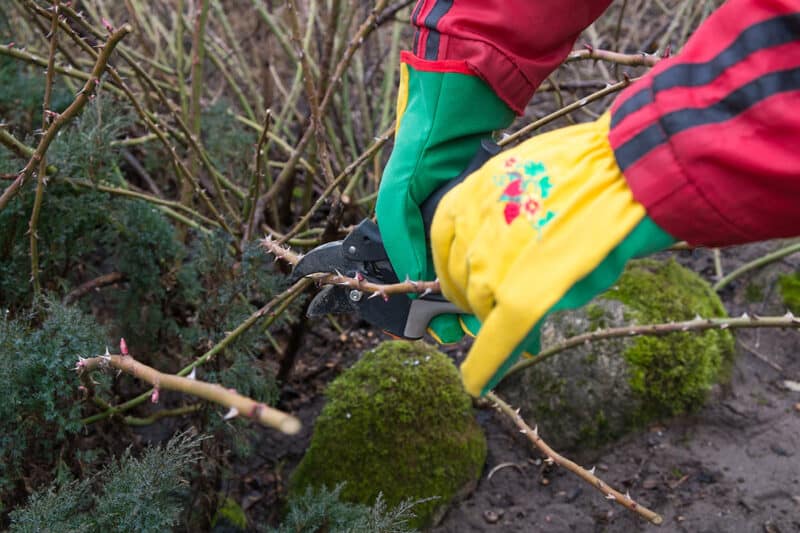
It’s time to start pruning. Look for dead canes. These are the hollow stems that don’t have any new or green growth on them. Leave the green stems alone because those are living.
Now is also the time to remove old and diseased branches. You want to get these canes out of the way to stop pests from taking over the dead branches and infecting your entire bush.
Get down to the base of the bush and cut the dead wood at the bottom.
3. Open The Center of the Bush
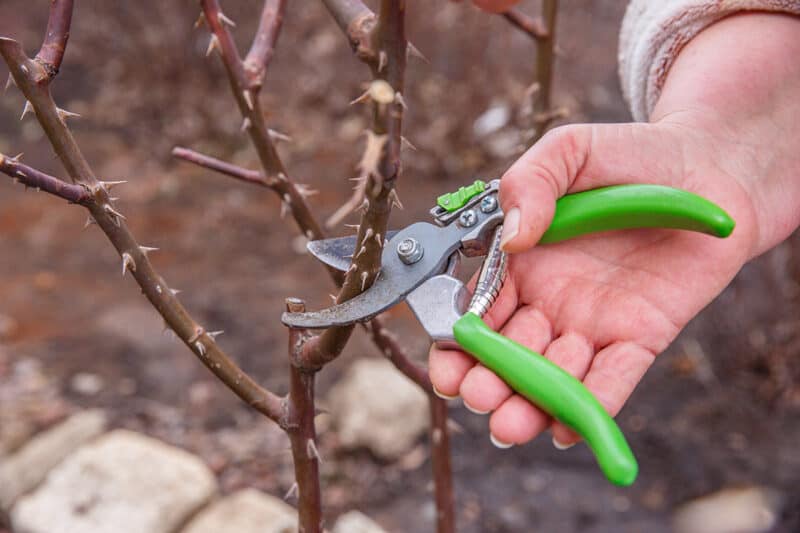
After the first two steps, you might have to cut some of the green canes. Examine the center of your bush and look for any branches that are rubbing together. That might seem like no big deal, but it can cause damage as the plant grows the summer, encouraging the development of a disease.
Your goal is to create a bush with upward-reaching branches. It should have a vase-like structure that is open.
Make sure you remove all of the suckers, which look like weeds growing up from the rootstock. Suckers remove sap from the plat and also clutters up the center of the roots.
When you cut your bushes like this, it helps to reduce the overall size. It also improves air circulation which prevents moisture buildup. Any type of moisture can make the bush vulnerable to fungal diseases. The last thing you want to do is deal with a fungal disease, so prevent it from forming.
4. Take Out Any Thin or Weak Growth
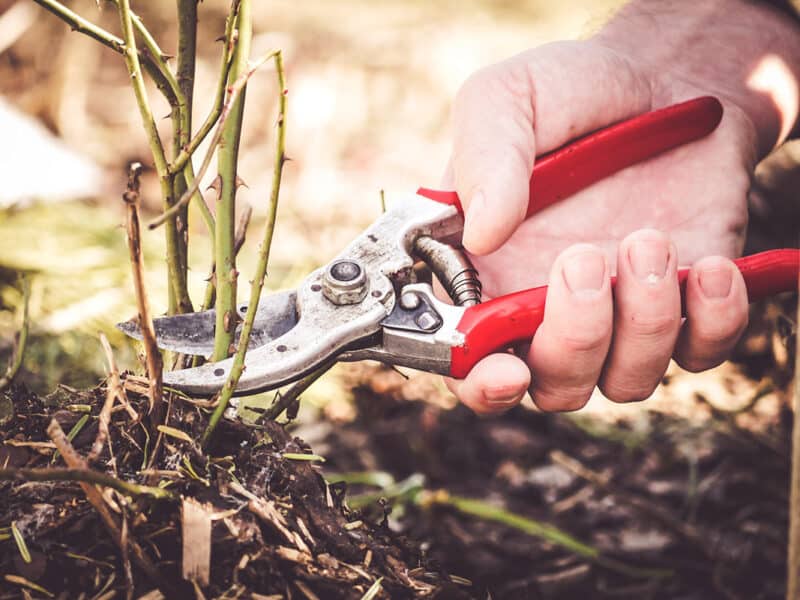
Take a close look at each of the remaining canes. The basic rule to remember is that you should remove anything that is thinner than a pencil unless it is brand new growth.
Why?
These thin canes will grow gangly and produce few if any blooms. They’re not useful to keep on your bush.
5. Prune The Remaining Canes
Now you’re going to work on the remaining canes. Shorten them by a third by cutting 1/4 to 1/2-inch above an outward-facing bud eye.

What does that mean? It can be confusing if you’ve never done this before. Bud eyes are small bumps that are typically found where a leaf meets the stem. Your goal is to look for these buds that face outward, not inward.
It might sound a bit complicated, but after you find the first one, it makes more sense and quickly becomes easier.
The reason the buds need to face outward is that new stems grow in the direction of the bud. So, you want your new growth to grow outward rather than inward.
All cuts should be made at a 45° angle, sloping away from the bud. The water should be able to run off easily.
It’s important to note that, while roses can be cut back yard, you shouldn’t remove more than one-third to one-half of the overall growth. Each cane should still have 3-5 buds left.
6. Seal Fresh Cuts
This step is important if you have cane borers, but many people who learn how to prune roses don’t remember to do it. Take a pruning sealer and follow the directions located on the bottle or bag.
Don’t worry about sealing healthy canes.
7. Make Sure You Clean Up The Debris
Your job is nearly done, but don’t stop just yet. All of the cutting is done – hooray – but you need to clean up the entire area underneath of your rose bush. Don’t leave all of the leaves, cut branches, and any other debris underneath of your plant.
This step is actually quite important, even if it feels like an afterthought. Pests love to use debris as a place to hide, and wet clippings can harbor bacteria and diseases that could damage your plants.
8. Feed Your Bushes
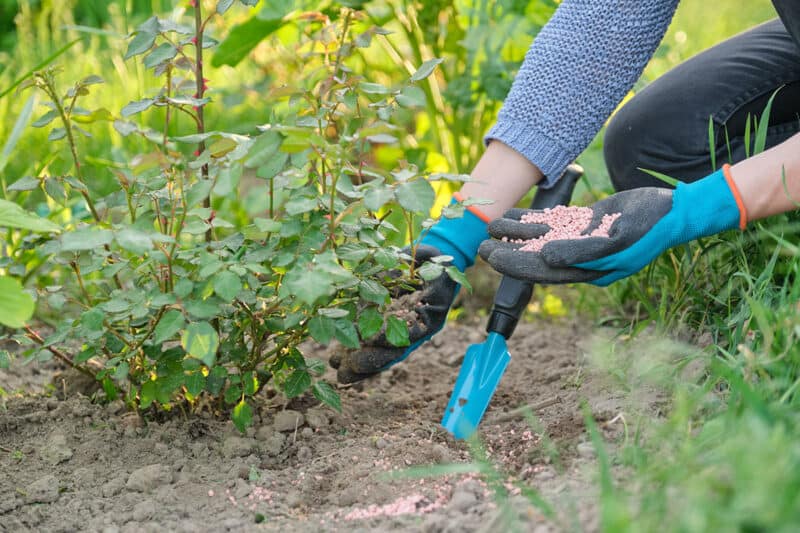
You don’t have to do this the same day as pruning, but it’s a smart idea. You don’t want to forget, and roses are heavy feeders. They need proper nutrients and plenty of them.
Feeding your bushes after pruning is a smart idea. They’re primed to grow rapidly, and giving a new dose of a long-lasting fertilizer is like giving your bushes the green light to start the race into summertime.
9. Clean Your Tools
Here is your last step, but it shouldn’t be forgotten. All of the tools that you use to prune your rose bushes need to be cleaned properly. You don’t know what diseases lived on those stems, and they can live on your pruning shears until the next time you use them.
You can use a diluted bleach solution of one part bleach to 10 parts water to clean your shears.
The End Result
In the end, your goal is to have 5 or so healthy, young canes on old roses, and 5 or so healthy, slightly older canes on modern roses. The plant should be shortened by about a third.
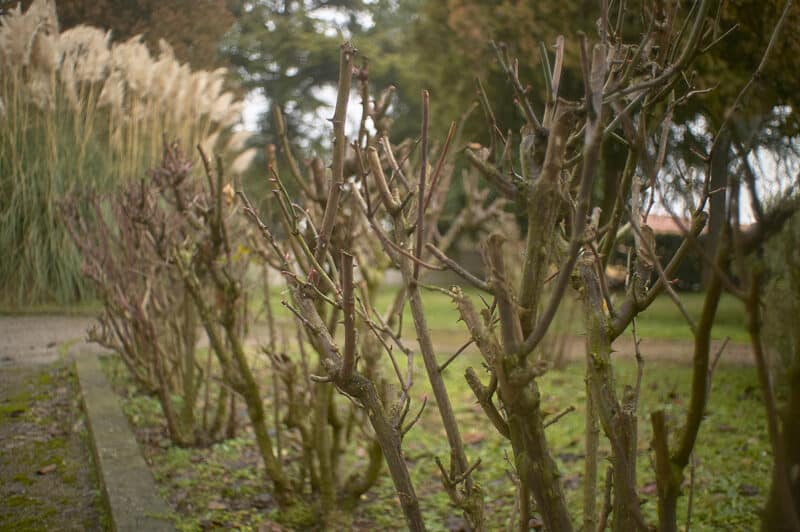
If you did everything right, once it starts growing again, the plant will fill out and be packed with blossoms.
Now that you know how to prune roses, you can take your pruning shears and get started. With practice, you’ll feel more confident than ever pruning your bushes, and they’ll look better because of it.
